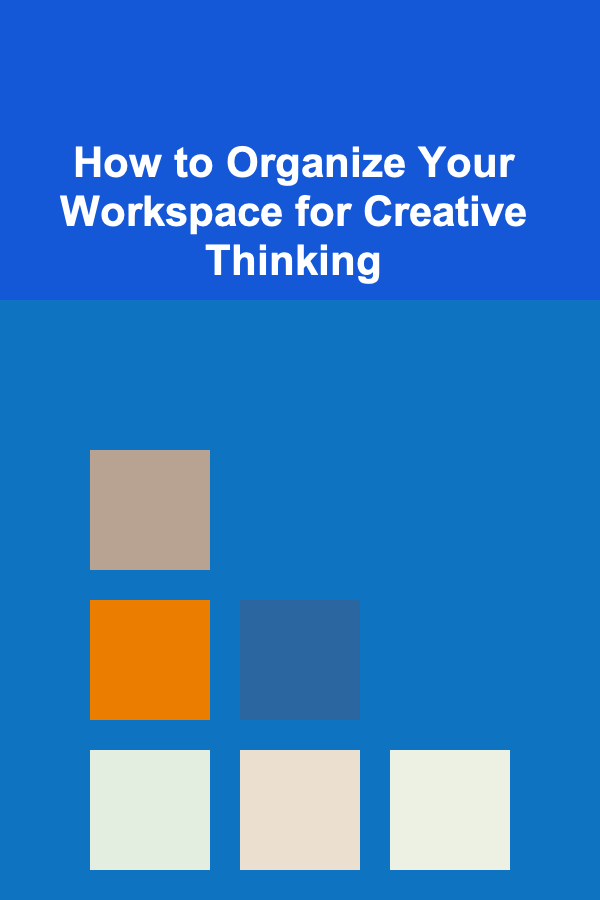
How to Organize Your Workspace for Creative Thinking
ebook include PDF & Audio bundle (Micro Guide)
$12.99$5.99
Limited Time Offer! Order within the next:

In a world that increasingly values innovation and creativity, the environment in which we work plays a crucial role in shaping our ability to think creatively. An organized workspace can either foster or hinder creative thinking; therefore, understanding how to structure your environment effectively is essential. This comprehensive guide will explore various strategies, tools, and techniques to organize your workspace for enhanced creativity.
Understanding the Connection Between Workspace and Creativity
1.1. The Role of Environment in Creativity
The environment in which we work is more than just a backdrop; it serves as a catalyst for creative thought. Research shows that individuals often thrive in unexpected and stimulating environments. A well-organized workspace can enhance focus, reduce stress, and make room for new ideas. Conversely, a cluttered and chaotic environment can lead to distractions, anxiety, and reduced productivity.
Key Factors Influencing Creativity Include:
- Physical Space: The arrangement, size, and safety of a workspace can impact how freely one thinks.
- Sensory Inputs: Visual elements, sounds, and even smells can spark creativity or create barriers.
1.2. Psychological Insights into Workspace Organization
Psychological studies indicate that our surroundings can significantly influence our mood and cognitive performance. For example:
- Clarity vs. Chaos: A clear space often correlates with a clearer mind.
- Personalization: Adding personal touches can enhance comfort and inspire creativity.
By understanding these principles, you can leverage your workspace design to maximize creative potential.
Assessing Your Current Workspace
2.1. Identifying Clutter and Distractions
Before making changes, it's essential to assess your current workspace critically. Here's how:
- Visual Inventory: Take a moment to look around your space. What catches your eye? Are there items that distract you?
- Functional Evaluation: Identify what tools and materials are regularly used versus those that are rarely touched. Eliminate what you don't need.
2.2. Understanding Your Work Style
Recognizing your work style can help tailor your workspace for optimum creativity:
- Collaborative vs. Independent Work: Do you prefer working alone, or do you thrive in group settings?
- Dynamic vs. Static Tasks: Consider whether your tasks require movement or if they are predominantly desk-bound.
This self-awareness will guide your organizational efforts.
Designing an Inspiring Workspace
3.1. Choosing the Right Location
The location of your workspace matters significantly. If possible, choose a dedicated area that is:
- Quiet and Free from Distractions: A place where interruptions are minimized.
- Well-Lit: Natural light is ideal for enhancing mood and alertness.
3.2. Optimal Layout and Configuration
How you arrange your workspace can influence your workflow. Consider:
- Ergonomic Positioning: Ensure your desk and chair promote good posture. The right height can prevent discomfort and distraction.
- Zoning: Create specific areas for different activities (e.g., brainstorming, computer work, reading). This separation can help maintain focus.
3.3. Incorporating Color and Lighting
Colors have psychological effects that can impact creativity. Some recommendations include:
- Calm Colors: Blues and greens can create a tranquil atmosphere conducive to deep thought.
- Accent Colors: Bright colors like yellow can stimulate energy and creativity.
Additionally, pay attention to lighting:
- Natural Light: Maximize exposure by positioning your workspace near windows.
- Task Lighting: Use adjustable lamps to provide focused light as needed.
Organizing Tools and Materials
4.1. Decluttering and Streamlining
Streamlining your workspace is crucial for reducing distractions. Follow these steps:
- Purge Unnecessary Items: Remove anything that doesn't serve a purpose in your daily tasks.
- Daily Maintenance: Allocate a few minutes each day to tidy up your space.
4.2. Using Organizational Tools
Implement organizational tools to keep your workspace functional:
- Baskets and Trays: Use them to categorize items such as pens, papers, and gadgets.
- File Systems: Employ digital and physical filing systems to ensure easy access to important documents.
4.3. Creating Dedicated Zones
Creating zones for specific tasks can improve focus:
- Brainstorming Zone: A whiteboard or corkboard area for sketching ideas.
- Reading Zone: A comfortable chair or nook designed for reading and reflection.
Each zone should be equipped with relevant tools to facilitate creativity related to specific tasks.
Leveraging Technology for Creativity
5.1. Digital Tools for Organization
Technology can help streamline organization and creativity:
- Task Management Apps: Tools like Trello or Todoist can help you organize tasks visually.
- Note-Taking Apps: Applications like Evernote or Notion enable you to capture ideas on the go.
5.2. Apps That Foster Creative Thinking
Consider using apps designed specifically for enhancing creativity:
- Mind Mapping Tools: Applications like XMind or MindMeister help visualize thoughts and relationships.
- Creative Prompt Generators: Websites offering prompts can inspire creative thinking when you're feeling stuck.
These digital resources can complement your physical workspace and enhance your creative process.
Building Routines to Enhance Creativity
6.1. Setting Boundaries
Establishing boundaries between work and personal time is essential for fostering creativity:
- Dedicated Work Hours: Define specific hours for focused work to minimize distractions.
- Tech-Free Time: Allow yourself periods without technology to foster natural thinking.
6.2. Scheduling Breaks for Reflection
Regular breaks can rejuvenate your mind and enhance creative output:
- Pomodoro Technique: Use this method to work intensely for 25 minutes, followed by a 5-minute break.
- Nature Walks: Taking walks outside can refresh your perspective and stimulate new ideas.
Incorporating breaks allows your brain to process information and make connections.
Fostering a Growth Mindset
7.1. Embracing Failure as a Learning Opportunity
Failure is often essential for growth. Cultivate a mindset that views setbacks as learning experiences:
- Reflect on Mistakes: After a setback, take time to analyze what went wrong and how to improve.
- Seek Feedback: Encourage constructive criticism to refine your creative outputs.
Embracing failure fosters resilience and opens doors to innovative thinking.
7.2. Continuous Learning and Skill Development
Maintaining a commitment to lifelong learning fuels creativity:
- Online Courses: Enroll in courses that expand your skill set and introduce new concepts.
- Workshops and Conferences: Participate in events that expose you to diverse perspectives.
Continual learning adds depth to your creative toolkit.
Case Studies: Creative Workspaces in Action
8.1. Google's Dynamic Offices
Google is renowned for its innovative office designs that encourage creativity. Their spaces feature collaborative areas, relaxation zones, and vibrant colors that stimulate imagination. By prioritizing employee well-being and creativity, Google continuously fosters a culture of innovation.
8.2. Pixar's Creative Design
Pixar's headquarters is designed to promote collaboration and creativity among employees. Open floor plans encourage interaction, while art installations stimulate inspiration. The combination of aesthetics and functionality creates an environment where creativity thrives.
Both case studies demonstrate how thoughtfully designed workspaces can lead to remarkable creative outcomes.
Conclusion
Organizing your workspace for creative thinking involves a careful interplay of environmental design, psychological insight, and practical organization. By assessing your current setup, designing an inspiring environment, utilizing technology, and fostering a growth mindset, you can unlock your creative potential.
As you embark on this journey, remember that creativity flourishes in an atmosphere that inspires curiosity, embraces failure, and encourages exploration. Take charge of your workspace today, and watch as your creative capabilities soar to new heights.
Reading More From Our Other Websites
- [Personal Finance Management 101] How to Plan for Health-Related Expenses and Save for Them
- [Home Cleaning 101] How to Organize and Clean Your Closet Efficiently
- [Personal Financial Planning 101] How to Implement Wealth Management Strategies for Long-Term Financial Growth
- [Organization Tip 101] How to Use Carabiners and Clips for Quick Access Gear
- [Home Budget 101] How to Save Money on Groceries and Reduce Food Waste
- [Personal Financial Planning 101] How to Improve Your Credit Score in 90 Days
- [Personal Care Tips 101] How to Use a Facial Scrub Before Applying Makeup
- [Personal Finance Management 101] Best Resources for Learning Personal Finance Management Skills
- [Home Party Planning 101] How to Create a Memorable Home Party with Unique Themes and Finger Food Ideas
- [Home Staging 101] How to Showcase a Functional and Stylish Home Office Space

How to Curate Recipes for Entertaining Guests
Read More
How to Find Free or Low-Cost Entertainment Options
Read More
How To Master Tricky Sounds in a New Language
Read More
How to Sanitize Your Kitchen and Avoid Cross-Contamination
Read More
How to Stage My Home for Virtual Tours: Best Practices and Tips
Read More
How to Use Magnetic Strips for Small Metal Items
Read MoreOther Products

How to Curate Recipes for Entertaining Guests
Read More
How to Find Free or Low-Cost Entertainment Options
Read More
How To Master Tricky Sounds in a New Language
Read More
How to Sanitize Your Kitchen and Avoid Cross-Contamination
Read More
How to Stage My Home for Virtual Tours: Best Practices and Tips
Read More